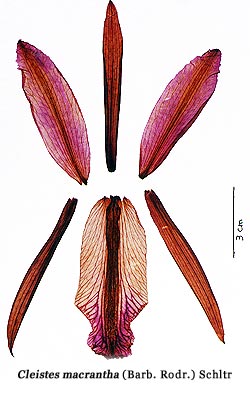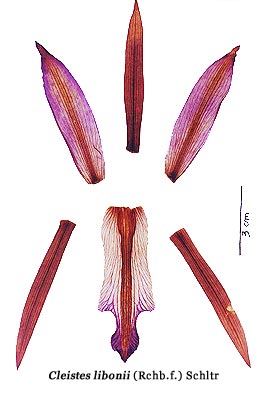The occurrance of Cleistes in
Rio de Janeiro city

| Maria
de Penha Fagnani The occurrance of Cleistes in Rio de Janeiro city |
 |
Orchids
from Rio de Janeiro city Introduction: In Rio de Janeiro city is quite common meeting people who, looking for running away of pollution and urban chaos, go up to Tijuca Forest, considered as the biggest urban forest known in the world. |
||||||||||
|
||||||||||
Within
Tijuca National Park, we can follow different itineraries and, one of them
leads to the Cristo Redentor's statue, a well known symbol of our city.
|
||||||||||
| In
this way, we find, in the embankments of the road, at about 600 m.s.m., some orchids which deserve to be in evidence. Although they are outstanding when blooming, they are not found in the collection due to their hard cultivation and to short life of their flowers which, in some species, last just for a day. |
|
|||||||||
Geographical distribution To our country, Hoehne names 42 species and Pabst 47, however they are found from Florida until the south of Brazil. It seems to be a genus in evolution, as they are really variable since the appearance (the way of standing) of the plant and floral segments until the size and the shape of the leaves. Nowadays, there are at about 50 species but in the past, 80 were assigned to this genus. Many of them are considered nowadays just synonyms. Etymology The name comes from the Greek "kleistos" (closed) because the flowers, in general, do not open entirely. Description They are terrestrial herbaceous, from medium to high size, with slim stems ; erect or light sinuous, alternate rigid (almost coriaceous) leaves with amplexicaul base. The blooming season is in March and April and three months ago, the capsules are already developed. After the dehiscence of the capsules, the leaves started to fade away as well the entirely stem and some months after the Cleistes disappear of the embankments. Some time after, they rise again with a new shoot, emerging from the nodular tuberoid roots. G. Pabst in "As orquídeas do Estado da Guanabara" (Rio de Janeiro city) pointed out five species to Rio de Janeiro city, all of them finding in Tijuca Forest. In the way to the statue of Cristo Redentor we identified two species: C. libonii (Rchb. f.) Schltr. and C. macrantha (Barb. Rodr.) Schltr. |
||||||||||
|
|
|||
|
C.
macrantha
|
C.
libonii
|
Main
differences between the two species
|
 |
 |
Pollination
The Cleistes do not offer nectar, but they are visited by bees which look for food. The strategic of pollination seems to be the one of false reward, although swollen ovaries have been found with the flowers completely closed (cleistogamy). They are considered primitive Epidendroideae by Dressler, as they have
incumbent anther and two soft pollinia (granulose) and have been classified
as Neottioideae by Garay. They belong to one of those groups of orchids
which need to be more studied in order to clarify multiple aspects still
unknown of their biology.
|